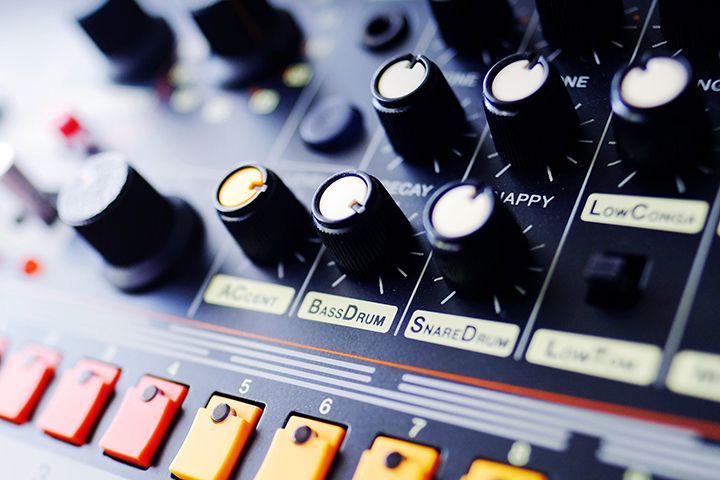This guide offers a few suggestive mixing techniques to help you get starting at shaping your kick drum. Learn how to get more punchy and powerful kicks.

Kick Drum Mixing
Kick drums are the musical heartbeat that drives music in most scenarios. It is a fundamental element that guides the rhythm and sets the vibe. Careful attention to shaping and enhancing the kick is essential. However, getting the kick to sit right in the mix can be challenging.
The type of kick you use depends on the genre and creative direction of your music. Therefore, the processing approaches will change depending on your music and the source material. Below are a few suggestive mixing techniques to help you get starting at shaping your kick drums.
1. Source Material
Choosing a kick that works well with your music is crucial. Sample packs offer a variety of different kick sounds to accommodate any genre. There are also kick instrument plugins such as KICK , BazzISM , and Battery. Either way, it’s important to choose or create the best quality kick from the beginning to use as a starting point. Composing a track around a weak or insufficient kick will cause problems later on.
2. Tuning
When choosing a kick, it’s often necessary to think about its relation to the key of your track. Tuning the kick to the key of your track will help it sit better in the mix. Also, tuned kick drums often sound harmonically pleasing in the mix and tend to groove better with the bass.
This technique requires finding the root note of your track and then matching the key of the kick to that note. There are several ways to identify a kicks root note. EQ’s with a frequency analyzer work great as well as tuning devices like Ableton Live’s Tuner. For example, analyzers will display the dominant resonant that indicates the kicks fundamental note. Once you know the root note of your kick, transpose its pitch to the desired key.
[yuzo]
3. Root vs. Fifth
Tuning the kick to a fifth (+7 semitones) above the fundamental note is another effective technique. This method is useful when the kick and bass consistently fight to occupy the same frequency range. The fifth separates the two elements while allowing them to play in harmony.
4. Kick Tail
Size matters when it comes to kick and bass relationships. Overlapping frequencies in the low-end of your mix causes several problems and reduces valuable headroom. It’s crucial to decide which element will be more dominant in the mix, the kick or the bass. One must give space to the other.
In addition, the length of the tail depends on how busy your mix is and how the bass interacts with the kick. For example, if you have a short stabby bass, then a longer boomy kick may fill out the low-end better. However, if you have a busy mix with longer sustaining bass notes, then a shorter kick may work better to avoid any conflicts.
5. Saturation
Harmonics is an important characteristic when it comes to the perceived loudness of low frequencies. Applying saturation or distortion to a kick accentuates its harmonic frequencies, thickens the overall sound, and improves presence. This move also gives the kick more punch and helps it cut through the mix better. In addition, saturation applies subtle compression that helps “glue” layered kicks together to create a more cohesive sound. Moreover, this technique helps the kick translate better through smaller speakers like laptops and smartphones. Third-party plugins like Soundtoys Decapitator , FabFilter Saturn , and iZotope Trash work great!
6. Equalization
Equalization is a vital process when sculpting kick drums. There are various frequency ranges you might consider treating when trying to enhance your kicks. Using a digital parametric EQ like FabFilter Pro-Q , try addressing the following frequency ranges:
Unnecessary Frequencies
Cutting unnecessary sub frequencies is a good place to start when shaping your kicks with an EQ. Using a highpass filter, try cutting anywhere below 50 Hz to tighten the kick and remove useless rumble. Conversely, if there is a lot of unnecessary high-end energy or instrument bleed, try cutting anywhere above 10 kHz with a lowpass filter.
Low-End Body
Accentuate the kick drums dominant low frequencies by boosting anywhere between 45 Hz and 200 Hz . Sweep this region with a bell curve filter to find the fundamental frequency or sweet spot. Next, boost to taste and widen the Q to keep the boost smooth. For a more punchy kick that feels like it’s hitting you in the chest, try applying another boost between 100 Hz and 200 Hz with a narrower Q. For a deeper kick that hits you more in the stomach, try boosting between 50 Hz and 100 Hz . Furthermore, if your kick is still lacking low-end thump or has too much body, try applying a shelving filter to either emphasize or reduce frequencies between 70 Hz and 100 Hz . Be cautious not to cause clarity issues by boosting excessively.
Boxiness
To tighten up the kick further, try cutting frequencies with a bell curve filter between 200 Hz and 500 Hz . This region often sounds boxy. Removing frequencies in the region opens up the low end and tightens the upper mids. This move will also give your kick more definition.
High-End Snap
Finally, look for the beater sound or “click” anywhere between 2 kHz and 5 kHz . Sometimes the “click” can even be heard as high as 10 kHz . Subtle boosts in this region can give the kick more definition and help it sit better in the mix.
7. Compression
Compression is another valuable process used to shape the dynamics of your kick. Treating your kick with compression adds punch and power. However, used incorrectly can reduce the impact of the sound, so only apply compression when needed.
When compressing your kick, try starting with a slow attack to preserve the “click” transient and set the ratio to 4:1. The release setting depends on the length of the kick tail. Faster release times work better for short kicks while slower release times work better on longer kicks. Also, when adjusting the release ensure the compression recovers back to 0 dB before the next kick hits to avoid level drops. Lastly, adjust the threshold to a level that sounds good to you. Sometimes 1 dB to 3 dB of gain reduction does the trick while other times 6 dB of gain reduction may give better results. Use your ears!
Alternatively, multiband compressors like Waves C4 and FabFilter PRO-MB offer a more modern approach to processing dynamics. Multiband compression separates the frequency spectrum into different bands so that each has its own unique compression settings. These versatile tools allow you to focus on precise frequency ranges that need enhancement. For example, you could compress a kicks lower frequencies much harder than the upper frequencies. This technique gives the kick a more consistent low-end while retaining dynamics in the high-end.
8. Stereo Imaging
Placing your low frequencies centrally in the mix is extremely important. Kick and lower bass frequencies should always be in mono for several reasons. Keeping low frequencies in mono retains punch, helps avoid phasing issues, and allows the low-end to translate appropriately on mono speaker systems. In addition, low frequencies carry a lot of energy and will take up more space in a mix than higher frequencies. Centering them clears space for elements with stereo information.
9. Parallel Processing
Parallel processing is an excellent technique used to give your sounds more power and punch without affecting the original sound source. This type of processing is often applied either by an effects wet/dry mix control or by routing sounds to an auxiliary track with effects loaded. This technique allows you to mix a processed signal with the original signal to achieve a fuller sound. Below are a few examples:
Parallel Compression
Sending your kick through an auxiliary track loaded with a compressor adds depth, punch, and presence. This technique also allows you to enhance the perceived loudness while preserving the transients and dynamic range. Moreover, parallel compressors are often set up to compress more aggressively. This gives you the best of both worlds, dynamic range, and compressed fatness.
Parallel Saturation
Applying saturation directly to the kick can change its tone and character. If you are looking to add more bite without affecting the original sound then try running the kick through an auxiliary track loaded with a saturator. Alternatively, you can also drive the saturation on the kick track and adjust the wet/dry control. This technique will give you loudness and presence without altering the original sound.
Short Reverb
In most scenarios, the kick should be upfront and present. Kicks are generally left fairly dry. However, sometimes applying subtle amounts of reverb helps create space and cohesion. When applying reverb to a kick, it’s recommended to send it to an auxiliary track with a reverb that has a small room size, short decay, and some pre-delay. This approach ensures the kick retains its punch without getting masked by a buildup of reverb. It’s also important to cut the reverbs low frequencies with a highpass filter. Plate reverbs like the Soundtoys Little Plate and UAD EMT 140 often work the best on kicks and bass. Avoid hall reverbs unless you’re doing something creative during a breakdown. Gating the reverb is another method used as well to control reverb tails.
10. Transient Shaping
If your kick still needs more punch, try running it through a transient shaper like SPL Transient Designer or Schaack Audio Transient Shaper.
Transient shapers work great at controlling the attack and sustain characteristics of sounds. Most transient shaping plugins only have two primary controls to process dynamics: attack and sustain.
When processing your kick, these efficient tools are used to quickly increase or decrease the attack portion of a sound. They are also used to simultaneously amplify or attenuate the sustain envelope. This technique works great for boosting the “click” to help the kick cut through the mix or to tighten up its tail.

Turn your passion for music into a Profession: Learn more about our Music School Programs!
MORE ARTICLES FROM THE ICON BLOG

FIND YOUR SOUND, HONE YOUR CRAFT:
Are you ready to turn music into a career? ICON prepares students to become music producers, composers, performers, recording artists, professional DJs, and entrepreneurs in the entertainment industry. Click below to get information about our award-winning programs:

